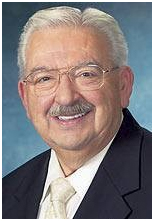Former CSEA President Chuck Valdes dies under mysterious circumstances
Posted 9 years 214 days ago ago by

Charles P. “Chuck” Valdes, who served three terms as president of the California State Employees Association (CSEA) and 20 years on the Board of Administration at the California Public Employees’ Retirement System (CalPERS) Board of Administration, died Sept. 2. The man who lived with him is accused of battery, corporal injury to a spouse or cohabitant and elder abuse.
Charges were filed against Clarence Irdell Munson, the 55-year-old roommate of Valdes, in connection with an Aug. 24 incident involving Valdes, who was 74.
At press time, authorities were still waiting for a determination from the coroner’s office on Valdes’ cause of death.
Munson, who is reportedly in custody on $110,000 bail, was scheduled for a preliminary hearing on Sept. 29.
CSEA’s current president, Marilyn Ferrasci-Hamilton, said she knew Valdes as a CSEA officer [more than a CalPERS board member.]
“He was instrumental in getting Jerry Brown to give state employees a flat $50 pay raise when there was no money in the budget,” Ferrasci-Hamilton said. “He was a good president at the time he served.”
For 13 of the 20 years of his tenure with CalPERS, Valdes chaired the Investment Committee, but filed for personal bankruptcy himself twice in the 1990s.
He was never charged criminally in connection with the recent CalPERS scandal in which CalPERS’Chief Executive Officer Fred Buenrostro pleaded guilty to accepting bribes to help investors gain access to CalPERS, where they sought to do business. Former CalPERS Board Member Alfred Villalobos has also been charged with multiple crimes in the “play-to-pay” scheme. He has pleaded not guilty and is scheduled to go to trial early next year.
Valdes was named as one the people who may have taken expensive trips paid for by Villalobos.
Valdes did not run for election on the CalPERS Board of Administration in 2012 and another former CSEA President – JJ Jelincic – was elected to fill his seat. Still another former CSEA president, Robert Carlson, also served on the CalPERS Board of Administration during the same time as Valdes.
Jelincic recalled Valdes in his years at CSEA before the CalPERS board.
“His heart was always in the right place – wanting to protect pensions and benefits for state employees and retirees,” he said.
During his service at CSEA between 1979 and 1982, Valdes – an attorney from Caltrans – was at the helm during many victories, including:
• CSEA won a double override of Gov. Jerry Brown’s vetoes on state worker salary increases in 1979. A single override on any subject is unusual. In the 33 years before that, there had been only two other gubernatorial overrides.
• The first year of collective bargaining occurred in 1982, when CSEA negotiated strong two-year contracts in 10 civil service bargaining units representing 79,000 employees – nearly 70 percent of the rank-and-file employees and three-year contracts for two California State University units covering an additional 9,000 employees. The agreements provided solid foundations for future contracts.
• Contracts also included a new sick leave provision that allowed unlimited use of earned sick leave for the care of specified family members by removing a previous five-day annual limit.
• CSEA-sponsored legislation was enacted in 1981 giving retirees a 10 percent supplement to their monthly allowances through September 1982, plus the opportunity in future years to negotiate increases during the budget process instead of afterwards.
• CSEA successfully fought against a 1982 attempt by the Legislature to withhold $187 million in employer contributions to CalPERS in an attempt to reduce the state budget deficit.
• Vigorous opposition by CSEA helped defeat a bill to create a two–tier retirement system that would have drastically reduced retirement benefits for future employees.
• After many years of work by CSEA, a state-paid dental care plan was established for state and higher-education employees in 1982.
|